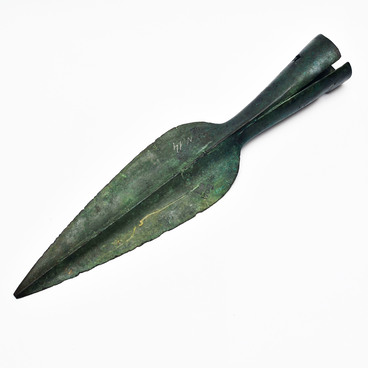Arrowheads and spearheads represent most frequent archeological finds on the sites of early man settlements in the Bryansk region. Over a period of 10th through 13th centuries, such settlements usually were camps of military servants and defense fortifications. Conventional weapons of the time were swords, arches, battle axes and spears known as lances.
Spearhead
Creation period
Early 11th century
Dimensions
35,8x2 cm
Technique
Steel, forging
Collection
Exhibition
0
Open in app#1
Spearhead
#2
#3
Old Russian spears were of two kinds – light throwing spears and heavier ones used in close-in engagement. They all had a wooden shaft which had a special name in the pre-Mongol Russia – stroozhye or oskepische, and a sharpened metal head. The shaft length differed depending on the weapon’s use: a small throwing spear (soolitsa) no longer than 1.5 meters; spears for dismounted combat could reach 2 meters. Horsemen typically used spears up to 3.6 meters long, which enabled then to throw the enemy off the horse from a safe distance.
#4
Such spears featured tips of various shapes. The most common shape was an elongated triangular blade with a massive shank, which inflicted deep wounds on the enemy. Heavy boar spears usually had tips shaped as the laurel leaf, and their striking component was forged into the shape of a long quadrangular stick.
#5
The spearhead from the Bryansk collection of ancient relics has the shape of a surgical instrument, lancet, which is rarely found in Russia. Such weapons are more typical of Scandinavian warriors. Archeologists assumed that mercenaries from the North served in Bryansk military units and brought their own spears of more familiar shape. The lance-shaped tips easily penetrated the armor and inflicted deep stab-wounds on the enemy.
The spearhead kept in the Bryansk National Museum of Local History was forged from steel in the early 11th century; it is merely 2 cm wide and about 36 cm long. The blade slightly tapering downwards smoothly extended to the shank, to which the shaft was fixed. The shank had two holes left so that it could be secured to the shaft with nails or rivets. The lance-shaped blade is strengthened by a raised rib running in its center, which kept the weapon from bending in battle even after hitting the ring-mail.
#6
Bryansk State Regional Ethnography Museum, a State budgetary cultural institution
read morehide
00:00
00:00
1x
Spearhead
Creation period
Early 11th century
Dimensions
35,8x2 cm
Technique
Steel, forging
Collection
Exhibition
0
Open in app
Share


